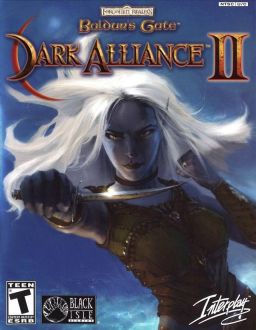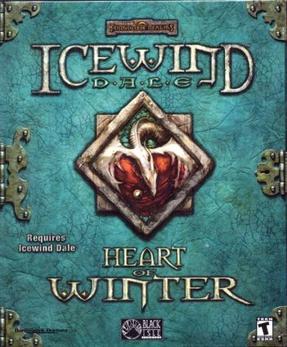
Baldur's Gate is a series of role-playing video games set in the Forgotten Realms Dungeons & Dragons campaign setting. The series has been divided into two sub-series, known as the Bhaalspawn Saga and the Dark Alliance, both taking place mostly within the Western Heartlands, but the Bhaalspawn Saga extends to Amn and Tethyr. The Dark Alliance series was released for consoles and was critically and commercially successful. The Bhaalspawn Saga was critically acclaimed for using pausable realtime gameplay, which is credited with revitalizing the computer role-playing game (CRPG) genre.

BioWare is a Canadian video game developer based in Edmonton, Alberta. It was founded in 1995 by newly graduated medical doctors Ray Muzyka, Greg Zeschuk and Augustine Yip, alongside Trent Oster, Brent Oster, and Marcel Zeschuk. Since 2007, the company has been owned by American publisher Electronic Arts.

Icewind Dale is a role-playing video game developed by Black Isle Studios and originally published by Interplay Entertainment for Windows in 2000 and by MacPlay for the Macintosh in 2002. The game takes place in the Dungeons & Dragons Forgotten Realms campaign setting and the region of Icewind Dale, and uses the 2nd edition ruleset. The story follows a different set of events than those of R. A. Salvatore's The Icewind Dale Trilogy novels: in the game, an adventuring party becomes enlisted as a caravan guard while in Icewind Dale, in the wake of strange events, and eventually discover a plot that threatens the Ten Towns of Icewind Dale and beyond.

Drizzt Do'Urden is a fictional character appearing in the Forgotten Realms campaign setting for the Dungeons & Dragons fantasy role-playing game. Drizzt was created by author R. A. Salvatore as a supporting character in the Icewind Dale Trilogy. Salvatore created him on a whim when his publisher needed him to replace one of the characters in an early version of the first book, The Crystal Shard. Drizzt has since become a popular heroic character of the Forgotten Realms setting, and has been featured as the main character of a long series of books, starting chronologically with The Dark Elf Trilogy. As an atypical drow, Drizzt has forsaken both the evil ways of his people and their home in the Underdark, in the drow city of Menzoberranzan.

Black Isle Studios is a division of the developer and publisher Interplay Entertainment that develops role-playing video games. It has published several games from other developers.

Baldur's Gate: Dark Alliance II is a 2004 hack and slash action role-playing game for PlayStation 2 and Xbox developed by Black Isle Studios and published by Interplay Entertainment, with distribution handled by Vivendi Universal Games in North America and Avalon Interactive/Acclaim Entertainment in Europe. It is the sequel to the 2001 game Baldur's Gate: Dark Alliance.

Baldur's Gate II: Shadows of Amn is a role-playing video game developed by BioWare and published by Interplay Entertainment. It is the sequel to Baldur's Gate (1998) and was released for Microsoft Windows in September 2000. Like Baldur's Gate, the game takes place in the Forgotten Realms—a fantasy campaign setting—and is based on the Advanced Dungeons & Dragons 2nd edition rules. Powered by BioWare's Infinity Engine, Baldur's Gate II uses an isometric perspective and pausable real-time gameplay. The player controls a party of up to six characters, one of whom is the player-created protagonist, while the others are certain characters recruited from the game world.

Icewind Dale: Heart of Winter is a 2001 expansion pack to the role-playing video game Icewind Dale, developed by Black Isle Studios and published by Interplay Entertainment. It introduced many changes and additions to the original game, and included a new campaign. A downloadable add-on to this expansion pack, titled Trials of the Luremaster, was released for free. Both the expansion and add-on were included in Icewind Dale: Enhanced Edition.

Icewind Dale II is a role-playing video game developed by Black Isle Studios and published by Interplay Entertainment, released on August 27, 2002. Like its 2000 predecessor Icewind Dale, the game is set in the Forgotten Realms fantasy setting in the Icewind Dale region. The player assumes control of a group of mercenaries in a war between the Ten Towns of Icewind Dale and a coalition of persecuted races and religions.

Neverwinter Nights 2 is a role-playing video game developed by Obsidian Entertainment and published by Atari Interactive. It is the second installment in the Neverwinter Nights series and is the sequel to BioWare's Neverwinter Nights, based on the Dungeons & Dragons fantasy tabletop role-playing game. Neverwinter Nights 2 utilizes an adaptation of the Dungeons & Dragons 3.5 edition rules. Players create player characters to represent themselves in the game, using the same character creation rules as found in the Dungeons & Dragons game. They may gain the assistance of additional party members, and they eventually acquire a keep that can be used as a base of operations. Neverwinter Nights 2 is set in the Forgotten Realms campaign setting—in and around the city of Neverwinter. The story is mostly unrelated to Neverwinter Nights and follows the journey of an orphaned adventurer investigating a group of mysterious artifacts known as "silver shards" and their connection to an ancient, evil spirit known as the King of Shadows.
Icewind Dale is a role-playing video game series developed by Black Isle Studios. It is set in the Forgotten Realms Icewind Dale region, but takes place decades before the events described in R. A. Salvatore's books which made the area a part of Faerûn.

Van Buren was the codename given to what would have been Fallout 3, a role-playing video game that was being developed by Black Isle Studios before the parent company, Interplay Entertainment, went bankrupt. This resulted in the company shutting down Black Isle, which in turn laid off the PC development team on December 8, 2003, effectively cancelling the game.

Baldur's Gate is a fantasy role-playing video game that was developed by BioWare and published in 1998 by Interplay Entertainment. It is the first game in the Baldur's Gate series and takes place in the Forgotten Realms, a high fantasy campaign setting, using a modified version of the Advanced Dungeons & Dragons (AD&D) 2nd edition rules. It was the first game to use the Infinity Engine for its graphics, with Interplay using the engine for other Forgotten Realms-licensed games, including the Icewind Dale series and Planescape: Torment. The game's story focuses on a player-made character who travels across the Sword Coast alongside a party of companions.

Baldur's Gate: Dark Alliance is a 2001 action role-playing video game developed by Snowblind Studios and published by Interplay Entertainment subsidiary Black Rock Studios for the PlayStation 2 and the Xbox consoles, with High Voltage Software handling the GameCube port, and Magic Pockets developing the Game Boy Advance version. CD Projekt was developing a version for Microsoft Windows, but was ultimately cancelled. In 2021, a 4K port of the game was released for the Xbox One, PlayStation 4, PlayStation 5, Xbox Series X/S, Nintendo Switch and PC.

Neverwinter Nights 2: Storm of Zehir is an expansion pack for the role-playing video game Neverwinter Nights 2, developed by Obsidian Entertainment and published by Atari Interactive. It was released in late 2008 in North America, Europe, and Australia. Like previous entries in the Neverwinter Nights series, Storm of Zehir is based on the paper and pencil fantasy role-playing game Dungeons & Dragons, and uses the game's 3.5 edition ruleset.
IdeaSpark Labs Inc. is a Canadian video game developer founded in 2009 by BioWare co-founder Trent Oster and former BioWare lead programmer Cameron Tofer. Beamdog's distribution service was launched in July 2010.
Baldur's Gate: Enhanced Edition is a remaster of the 1998 role-playing video game Baldur's Gate, developed by Overhaul Games, a division of Beamdog, and published by Atari. It was released for Microsoft Windows on November 28, 2012, with additional releases between 2012 and 2014 for iPad, OS X, Android and Linux and most recently for Xbox One, PlayStation 4, and Nintendo Switch on October 15, 2019. The remaster combines the original game, Baldur's Gate, with its expansion Baldur's Gate: Tales of the Sword Coast, retaining the original elements from both, while including additions, a separate arena adventure entitled The Black Pits, and a number of improvements some of which were imported from Baldur's Gate II: Shadows of Amn.

Icewind Dale: Enhanced Edition is a remake of the Black Isle Studios 2000 role-playing video game Icewind Dale and its expansions Icewind Dale: Heart of Winter and Trials of the Luremaster. Enhanced Edition was developed by Overhaul Games, a division of Beamdog, and published by Atari for Microsoft Windows, Mac OS X, Linux, iOS, and Android.

Baldur's Gate 3 is a 2023 role-playing video game developed and published by Belgian game developer Larian Studios. The game is the third main installment in the Baldur's Gate series, based on the tabletop fantasy role-playing system of Dungeons & Dragons. A partial version of the game was released in early access format for macOS and Windows in October 2020. It remained in early access until its full release for Windows in August 2023, with versions for PlayStation 5, macOS, and Xbox Series X/S releasing later that year.













